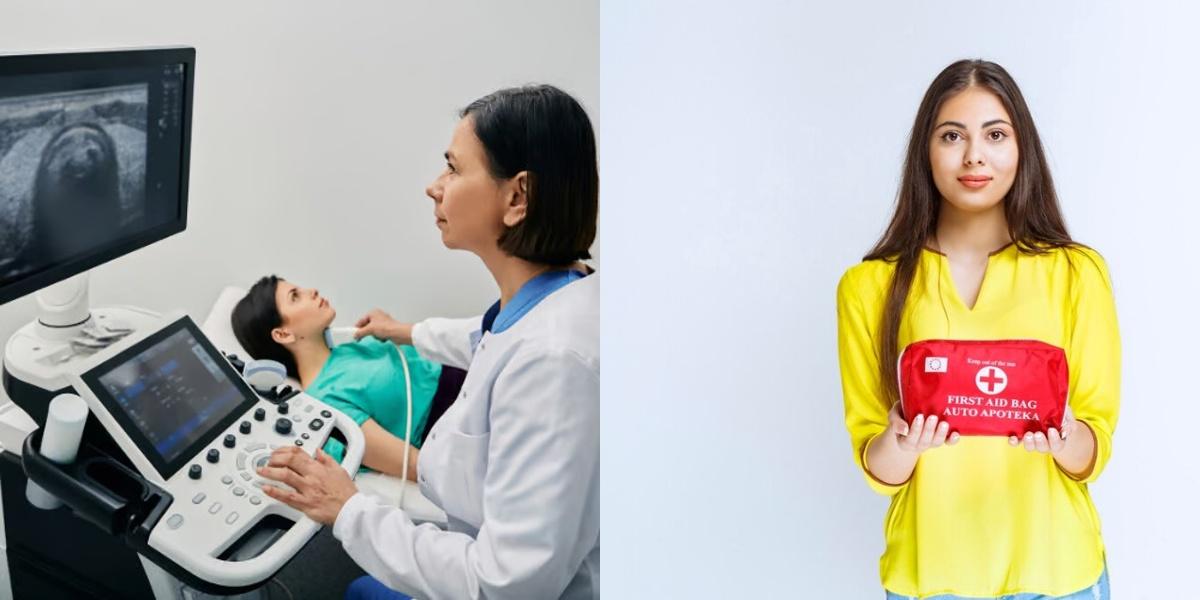Diagnostic Medical Sonographer vs First Aid

Want personalized recommendations?
Let's match you to the right program

Key Points:
- Diagnostic Medical Sonographers use imaging technology to diagnose medical conditions; First Aid providers offer immediate care for injuries and illnesses.
- Diagnostic Medical Sonographers typically earn higher salaries than First Aid providers.
- Demand for Diagnostic Medical Sonographers is expected to grow faster than the average job, while First Aid providers are needed in various settings.
- Diagnostic Medical Sonographers require formal education and certification, while First Aid training can be obtained through in-person or online courses.
- Becoming a Diagnostic Medical Sonographer requires a longer and more expensive educational program compared to First Aid training.
Vocational training programs provide students with the skills and knowledge needed to succeed in specific professions. Diagnostic Medical Sonography and First Aid are two vocational paths that offer rewarding careers in the healthcare industry. Each profession requires unique skills and training, and both play crucial roles in patient care.
Article continues after recommendations
Recommended for you
What is a Diagnostic Medical Sonographer and First Aid?
-
Diagnostic Medical Sonographer: A Diagnostic Medical Sonographer, also known as an ultrasound technician, is a healthcare professional who uses specialized equipment to produce images of a patient's internal organs, tissues, and blood flow. These images help physicians diagnose and monitor medical conditions.
-
First Aid: First Aid is the immediate care given to a person who has been injured or suddenly becomes ill. It involves assessing the situation, providing basic medical assistance, and taking necessary steps to stabilize the individual until professional medical help arrives. First aid skills are essential in emergency situations and can save lives.
Difference between a Diagnostic Medical Sonographer and First Aid
While both Diagnostic Medical Sonographers and individuals trained in First Aid contribute to patient care, there are fundamental differences between these two vocations:
-
Scope of Practice: Diagnostic Medical Sonographers work closely with physicians and use ultrasound technology to perform diagnostic imaging procedures. They are responsible for capturing high-quality images and providing preliminary findings to aid in patient diagnosis and treatment. On the other hand, individuals trained in First Aid provide immediate medical assistance in emergency situations until professional medical help arrives. Their focus is on stabilizing the patient and preventing further harm.
-
Level of Training: Diagnostic Medical Sonographers undergo extensive education and training. They typically complete an accredited program, which can range from 2 to 4 years in duration, and earn a degree or certificate in Diagnostic Medical Sonography. In contrast, First Aid training can be completed in a shorter period, usually through a certification course that covers basic life-saving techniques.
-
Equipment and Technology: Diagnostic Medical Sonographers work with specialized ultrasound machines and other advanced imaging equipment to capture images of a patient's internal structures. They are trained to operate and maintain these complex devices to ensure accurate and reliable results. On the other hand, First Aid providers rely on basic medical supplies and equipment, such as bandages, splints, and automated external defibrillators (AEDs), to provide immediate care in emergency situations.
Diagnostic Medical Sonographer vs First Aid: Job Description
The job descriptions of Diagnostic Medical Sonographers and individuals trained in First Aid differ significantly:
-
Diagnostic Medical Sonographer: As a Diagnostic Medical Sonographer, your primary role is to perform ultrasound procedures on patients. You will work closely with physicians to capture images of specific body parts or systems, such as the heart, abdomen, or reproductive organs. Your responsibilities may also include maintaining patient records, explaining procedures to patients, and ensuring the safety and comfort of patients during the imaging process.
-
First Aid Provider: As a First Aid provider, your job description revolves around providing immediate medical assistance in emergency situations. You may be called upon to administer CPR, control bleeding, immobilize fractures, or treat medical conditions such as allergic reactions or seizures. Your main goal is to stabilize the patient and prevent further harm until professional medical help arrives.
Diagnostic Medical Sonographer vs First Aid: Education and Training
The education and training requirements for Diagnostic Medical Sonographers and individuals trained in First Aid differ significantly:
-
Diagnostic Medical Sonographer: To become a Diagnostic Medical Sonographer, you will need to complete a formal education program in Diagnostic Medical Sonography. These programs are offered by colleges, universities, and vocational schools and typically result in an associate or bachelor's degree, or a certificate. The coursework includes anatomy, physiology, patient care, physics, and medical ethics. Additionally, you may be required to complete a clinical internship to gain hands-on experience.
-
First Aid Provider: Training in First Aid can be obtained through certification courses offered by organizations such as the American Red Cross or the American Heart Association. These courses typically cover basic life-saving techniques, including CPR, wound care, choking management, and AED usage. The training duration may vary depending on the course and can range from a few hours to several days.
Get courses selected just for you
Try our powerful search engine
Diagnostic Medical Sonographer vs First Aid: Career Outlook and Salary
Career outlook and salary potential are important factors to consider when choosing a vocational path. Here is a comparison of the career outlook and salary for Diagnostic Medical Sonographers and individuals trained in First Aid:
-
Diagnostic Medical Sonographer: The demand for Diagnostic Medical Sonographers is projected to grow rapidly in the coming years. This growth can be attributed to an aging population and increased reliance on diagnostic imaging for medical diagnosis. According to the Bureau of Labor Statistics, the median annual wage for Diagnostic Medical Sonographers was $72,510 in May 2020.
-
First Aid Provider: First Aid providers can find employment in various settings, including hospitals, schools, sports facilities, and community organizations. While the demand for individuals trained in First Aid may not be as high as that for Diagnostic Medical Sonographers, these skills are valuable and can complement other healthcare professions. The salary for First Aid providers can vary depending on the specific job and location.
Final Thoughts
Choosing the right vocational training program is essential for students looking to pursue a career in healthcare. Diagnostic Medical Sonography and First Aid are two vocational paths that offer unique opportunities to make a difference in people's lives. While Diagnostic Medical Sonographers specialize in diagnostic imaging using ultrasound technology, individuals trained in First Aid provide immediate medical assistance in emergency situations. Both professions require specific skills, education, and training. By understanding the differences between these vocations, students can make an informed decision and embark on a rewarding career in healthcare.
Dreambound offers programs in multiple locations. For in-depth information on the intricacies of these two vocations, their prerequisites, and steps to join, explore the following blogs:

Stephanie Dayak is the go-to person for everything related to automation and integrations at Dreambound. As a Certified Tax Technician turned tech whiz, her sharp eye for detail and passion for efficiency become evident in every project she undertakes. When not solving tech puzzles, she's out exploring the local food scene, cozying up with her dogs, or plugged into a thought-provoking podcast. She's an ardent believer in mixing fun with functionality!



